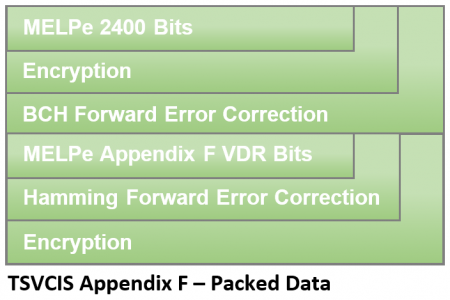TSVCIS Software
The Tactical Secure Voice Cryptographic Interoperability Specification (TSVCIS) follows common practices in speech coding and cryptography to provide robust security and to ensure the interoperability of next generation tactical secure voice radios. TSVCIS introduces the Wideband Waveform, which provides the framework for improved speech intelligibility, and robustness of defense radio communications.
TSVCIS provides the framework to improve speech quality of tactical secure voice communications. In the Wideband Waveform of TSVCIS the bit rates of MELPe have been extended to include data rates of 8000, 12000 and 16000 bps. This allows for the radio users to selectively determine the characteristics of the radio communication. If the radio communication is noisy, a lower MELPe rate can be selected and the number of parity bits used for the FEC can be increased. If the channel’s error rate is low, a variable data rate (VDR) speech coder along with MELPe 2400 data bits can be used to improve the intelligibility of the speech,. TSVCIS was designed to be inter-operable to with SCIP, so the MELPe bit rate extensions were designed to easily switch back to using standard Narrowband MELPe.

VOCAL’s enhanced Mixed-Excitation Linear Predictive (MELPe) vocoder is ideal for a range of low power and low bandwidth applications including PDAs, mobile devices and cell phones, VoIP, secure voice and radio, ground mobile and software defined radios as well as the Joint Tactical Radio System (JTRS), JTRS Handheld, Manpack and Small Form Fit (HMS) and Soldier Radio Waveform (SRW). It is commonly known in the U.S. as MIL-STD-3005 and in NATO as STANAG 4591.
Our MELPe TSVCIS voice compression algorithm is available either standalone, as an embedded software library, with a VoIP stack or as part of a complete design. MELPe may be licensed for a flat fee. VOCAL does not charge a royalty; nor is there any fee due to Compandent.
Forward Error Correction (FEC) is applied pre and post crypto on the MELPe and TSVCIS Bits as shown by the following diagram:

TSVCIS Software
- Includes MELPe 2400, 1200, and 600 bps rates
- Based on Naval Research Lab’s (NRL’s) Variable Data Rate (VDR) Speech Codec
- Wideband Voice 16 without FEC (TSVCIS Appendix E)
- Wideband Voice 16 with in-band FEC (TSVCIS Appendix F)
- Wideband Voice 16 Gateway – Narrowband – Wideband Crossbanding (TSVCIS Appendix G)
- Wideband Voice 12 with in-band FEC (TSVCIS Appendix H)
- Wideband Voice 8 with in-band FEC (TSVCIS Appendix I)
- Optional BCH and Hamming libraries
- Scalable narrowband voice codec augmenting the MELPe encoded parameters
- Uses a variable number of LSF parameters packed into octets (up to tcmax)
- AES Encryption
- Gateways/receivers may pass/use fewer LSF octets
- C Callable Interface
- Available a variety of processors and platforms
